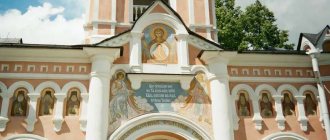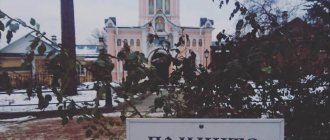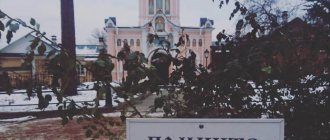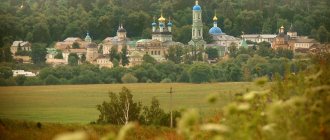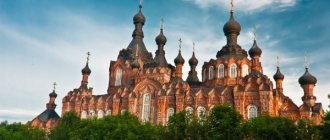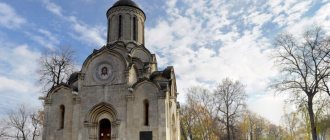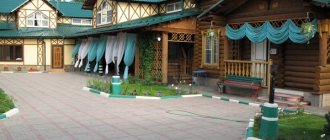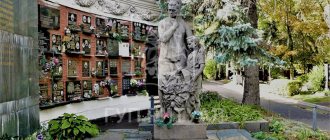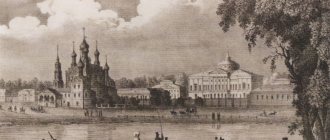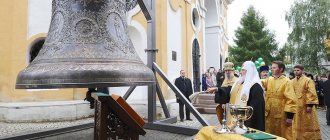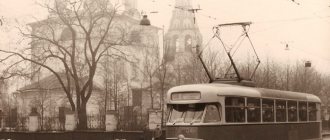Entrance to the Optina Pustyn Monastery HistoryWhat is Optina Pustyn famous forTour of Optina PustynTemples and other buildings Skete and surrounding area Where to liveHow to get there by car, train and bus Where is Optina Pustyn
Near the city of Kozelsk in the Kaluga region, on the banks of the small river Zhizdra, there is one of the most famous Russian monasteries - Optina Pustyn. Our small guide will help those who are planning to visit this monastery.
History of Optina Pustyn
The Vvedensky stauropegial monastery of Optina Pustyn - this is what this monastery is now officially called - is one of the oldest in Russia. It is not known for certain who decided to found it. The sources only mention that the Romanovs donated land to the already existing monastery, and under Peter I, some small deserts, including those near Kozelsk, were abolished. In total, about 500 monasteries were closed throughout Rus' during that period. The Optina monks were transferred to the Transfiguration Monastery in the town of Belev, but after a couple of years the hermitages were reopened, but the brethren had almost no means of subsistence.
The real revival of the monastery began at the end of the 18th century, when Metropolitan Platon of Moscow and Kaluga drew attention to Optina Pustyn, and three decades later the local Bishop of Kaluga (who would later become Metropolitan Philaret of Kyiv) ordered the construction of a monastery there. Optina has become one of the spiritual centers of Russia.
Holy Gates of Optina Hermitage
At the beginning of the 20th century, Optina Pustyn was a large, prosperous monastery. Divine services were held in 6 churches of the monastery and two churches of St. John the Baptist monastery. The library stored about 60 thousand books and manuscripts.
After the revolution in 1918, the monastery was closed. Arrests of the monastery leaders and searches of the monastery's cells began immediately. At first, the Optina Pustyn artel was organized from able-bodied monks, but in 1923 that too was closed. About 300 monks were expelled, some of them were arrested and sent to camps. The lands and barnyard, a herd of cows that previously belonged to the monastery, went to Semkhoz. For some time, a museum was opened on the territory of the monastery, but already in 1927 its activities ceased. The property of the monastery was dismantled by local residents, some of the things were sold at an auction held right on the porch of the cathedral. At the same time, the cemetery was devastated: cast-iron monuments and fences were sent for melting down, marble and granite tombstones were piled up, grave mounds were razed to the ground. Rare books from the collection were sent to Moscow to the Lenin Library, while the rest were taken apart for next to nothing by local residents for household needs.
The buildings of the monastery changed owners many times: they housed communal apartments, a sawmill, a rest home, a concentration camp for Poles, and a military unit. After the war, the buildings, including the monastery wall, began to be dismantled into bricks.
The last Optina monk who lived in the monastery before the revolution died in 1981, just 6 years before the moment when Optina Pustyn was returned to the church. In 1987, the restoration of the monastery began.
Why is Optina Pustyn called so? Everything is simple with a desert - this is how a secluded monastery in a sparsely populated desert area was called from ancient times. Why Optina? The most popular version is that the monastery was founded by a repentant robber named Opta. However, etymologists put forward another version: previously the monastery was common to monks and nuns, they lived there together, that is, “wholesale”, which was permissible until the adoption of the Council Decree of 1503, which introduced the division of monasteries into male and female.
What is Optina Pustyn famous for?
Monasteries often become famous thanks to miraculous icons and relics of saints, but throughout the 19th-20th centuries, believers knew Optina Pustyn thanks to the elders: the Monks Leo and Macarius, Moses and Anthony, Ambrose and their followers.
Flower garden in Optina Pustyn (source https://www.optina.ru)
The revival of the ancient traditions of eldership in Optina Pustyn dates back to the first half of the 19th century. Before this, the brethren paid more attention to the external side of monasticism, observing fasts and leading an ascetic life. In 1829, the Monk Leo moved to the monastery, and he was entrusted with the leadership of the monks. Elder Leo tried to follow what Paisiy Velichkovsky preached: for monks, first of all, spiritual life should be important, one should read the works of the holy fathers and apply their principles in monastic life.
In the middle of the 19th century, the Monk Macarius and his assistants began not only to study, but also to translate and publish Greek and Slavic patristic works. The monks devoted all their free time from services to reading. From Eastern patristics (the works of the holy church fathers) they received advice and guidance about life and began to provide spiritual guidance. This is how an eldership arose in Optina, finally establishing itself in the monastery in the 1840s.
According to the definition of St. Ambrose of Optina, eldership is a special spiritual union, which consists in the sincere spiritual obedience of spiritual children to their spiritual father, in frequent confession to the elder of all movements of thought and heart and asking for advice and blessings for any actions. The student completely trusts his teacher, renouncing the arbitrariness of his fallen mind, which is unable to understand the Creator’s plan, unlike the elder who has achieved dispassion and purity of heart, to whom the will of God is revealed.
N.V. Gogol and V.A. Zhukovsky, F.I. Tyutchev and I.S. Turgenev, F.M. Dostoevsky and P.I. Tchaikovsky and many other famous representatives of Russian culture came to the elders in Optina Pustyn. Elder Macarius was helped in publishing books by his spiritual son, the Slavophile Ivan Kireyevsky (he is buried on the territory of the monastery). I visited the monastery several times and talked with Elder Ambrose L.N. Tolstoy.
In 1988, the Monk Ambrose of Optina was glorified by the Local Council of the Russian Orthodox Church. On July 26-27, 1996, the remaining thirteen venerable Optina elders were canonized as locally revered saints. In 2000, they were glorified by the Jubilee Council of Bishops of the Russian Orthodox Church for church-wide veneration, and now believers can turn to them in prayer.
Optina Pustyn is not the only monastery in the Russian Empire that is famous for its tradition of eldership. Thus, the corresponding charter, dating back to the Monk Paisius Velichkovsky, was also in the Glinsk Hermitage - now this male stauropegial monastery belongs to the Ukrainian Orthodox Church.
Schema-Archimandrite Iliy
Optina elders - who are they, why did people from different parts of the country try to get an “appointment” with them? These are people who have some kind of spiritual vision.
Schema-Archimandrite Eli (Alexey Nozdrin) has such vision, according to the monks of Optina Pustyn. Now he lives in Peredelkino and is the personal confessor of Patriarch Kirill of Moscow. When the elder was in the Optina Hermitage, people continuously came to him. He didn't accept everyone. But if a person was lucky enough to talk with Elder Eli, he could receive completely unexpected advice from him. For example, leaving a business, adopting a child from an orphanage, or even joining a monastery.
Alexey Afanasyevich Nozdrin - that was his name in the world. He was born in 1932 into a peasant family. In 1949 he graduated from school. While serving in the army, he joined the Komsomol, but upon returning home, he repented of his actions and burned his Komsomol card.
In 1958, Nozdrin graduated from a technical school in the Moscow region. Then he worked at a factory in the city of Kamyshin. There was only one temple here, which the future clergyman visited. Nozdrin, on the advice of his confessor, graduated from the Leningrad Theological Academy. In 1966 he was tonsured a monk. At the end of the eighties, he was sent to Optina Pustyn, where at that time the restoration of the monastery began.
Excursion to Optina Pustyn
In front of the entrance to Optina Pustyn there is a fairly large parking lot where you can leave your car. Next, about a couple of hundred meters to the entrance from the barrier to the gate you need to walk. To your left there will be a small grocery store where, among other things, they brew delicious real coffee.
Also on the left you will see a kiosk with monastery products: bread, pies, honey.
Go to the gate: to the right and left of you there will be small neat houses in which the hotel premises are located. Also, the hotel building and the refectory are located near the wall of the monastery to the right of the entrance.
Wall of the Optina Pustyn Monastery
Temples and other buildings on the territory of Optina Pustyn
You will enter Optina Pustyn through the Holy Gates . If women are wearing trousers, they can take skirts here. The monastery's excursion service is located in the same building.
The excursion service operates daily from 8.30 to 17.00. The average duration of the excursion is 1–1.5 hours. The amount of donations depends on the number of excursionists in the group: 150–200 rubles for an adult and 50 rubles for children. It is also possible to conduct individual excursions for small groups (from 1 to 10 people), donations of 2000 rubles. More detailed information and contacts for booking excursions can be found on the official website of Optina Pustyn.
A few steps forward, and on your left there will be a small single-domed Church of the Transfiguration of the Lord . It was built in 2007 in pseudo-Russian style. In the temple, custom prayers with blessing of water are performed daily. The relics of St. Raphael (Sheichenko) rest in it.
Church of the Transfiguration of the Lord and the bell tower of Optina Hermitage
A little ahead on the right rises the austere massive single-domed Church of the Kazan Icon of the Mother of God . The largest temple in Optina Hermitage was built in 1811 and restored in 1996. This was the only church where, from the moment the monastery was closed, the brethren continued to worship until 1923. In the temple, hidden under cover, are the holy relics of the Optina elders Moses, Anthony and Isaac. Nowadays late Liturgy and evening services are celebrated there every day. On Sundays and holidays there are all-night vigils and late Liturgies.
Temple of the Kazan Icon of the Mother of God in Optina Hermitage
Further behind it, on your right side, is the main cathedral of Optina Hermitage. It is dedicated to the Entry of the Blessed Virgin Mary into the Temple . Previously, there was another stone church in its place, but it was dismantled in 1689, and in its place in 1750-1771 a new temple was erected with five domes on high elegant drums in the Russian Baroque style. The cathedral contains the relics of the Optina elders: in the northern aisle - St. Ambrose, in the refectory near the southern wall - St. Nektarios, as well as the especially revered Kazan Icon of the Mother of God. In the Vvedensky Church, the midnight office, early liturgy, requiem service, prayer service with akathist to St. Ambrose are celebrated daily, and on Sundays: early liturgy, prayer service with akathist to St. Ambrose.
Cathedral of the Presentation of the Blessed Virgin Mary into the Temple
You entered Optina Pustyn through the modern Holy Gate, but before the revolution the main entrance was in a different place. On your left, opposite the Vvedensky Cathedral, you will see from the inside another now locked gate, but, unfortunately, you will not be able to look at the long, majestic staircase leading from the bank of the Zhizdra - it has been preserved only in photographs. Previously, pilgrims could only get to the monastery by crossing the river and climbing many steps.
Above this ancient entrance is the gateway Vladimir Church , consecrated in 1988. It became the first place where regular services began to be held after the monastery buildings were returned to the church.
Further on your left is the building of the fraternal refectory , built in 1858, and on your right is the temple of the Venerable Mary of Egypt and the Holy Righteous Anna . Initially, in the 1820s, the refectory for the brethren was located in it, but after another building was erected opposite, a church was built in this building and consecrated in 1858. In the 1880s, on the initiative of Elder Ambrose, the temple was greatly rebuilt: two limits appeared in it. Now part of the temple premises is occupied by a publishing house and an icon-painting workshop.
Temple of St. Mary of Egypt and St. Righteous Anna
Let's go back a little and, having passed the main Vvedensky Cathedral, turn left. There you will see a small belfry . In this place, in 1993, on Easter, two monks Trofim (Tatarnikov) and Ferapont (Pushkarev) were brutally stabbed to death. The killer overtook the third victim, hieromonk Vasily (Roslyakov), not far from the monastery tower.
To the left is the laconic single-domed Church of the Vladimir Icon of the Mother of God . It was built at the end of the last century on the site of a completely destroyed hospital church built in 1809-1811. Now it is a temple-tomb: it contains the holy relics of Saints Leo, Macarius, Hilarion, Anatoly (Zertsalov), Barsanuphius, Anatoly (Potapov), Joseph - discovered in 1998. Confession and a prayer service with an akathist to the Venerable Elders of Optina are held daily in the church.
Temple of the Vladimir Icon of the Mother of God in Optina Hermitage
chapel built in 2008 at the burial site of the Optina brethren killed in 1993. A funeral litany is held there on Saturdays.
The monastery and surroundings of Optina Pustyn
On the east side of the monastery there is the monastery of St. John the Baptist . Coming out of the gate of Optina Hermitage, go along the wall to the left. Soon you will come to a forest with tall, beautiful ancient trees. Follow the path, it will lead you to the Skete. The beginning of hermit-dwelling in the Optina Hermitage was laid by Schemamonk Ioannikiy, who settled in the depths of the forest in a small apiary at the beginning of the 19th century. After his death, several hermit elders from the Roslavl forests moved to this place. They began to equip the monastery.
Ancient engraving: view of the Baptist Skete (source https://www.optina.ru)
What the Skete looked like before the revolution can be easily imagined by reading how F. M. Dostoevsky described the monastery in The Brothers Karamazov: “A small pink bell tower made of brick towered above the gates; on both sides, outside the fence, there were “huts” - a kind of reception room where the elders went to talk with women: they were forbidden to enter the monastery. Silence reigned within him. It was a beautiful garden, full of colorful flowers growing around the church and cells. In such an environment, the Russian elders cultivated their best spiritual fruits for almost a century.”
Not far from the entrance to the monastery, to the right you will notice the Ambrose Well . According to legend, it was dug up with the blessing of Elder Ambrose, at the place he indicated. The source was consecrated in honor of Saint Ambrose of Milan, the heavenly patron of the venerable elder. Before the revolution, religious processions were made to this well from the Skete, and the water in it was blessed. There are several descriptions of miraculous healings.
After the revolution, the well continued to be used by laymen who settled on the territory of the Skete. When the monks returned to the monastery, they re-consecrated the Ambrose Well and, using pre-revolutionary photographs, restored its appearance.
Ambrose Well at the Skete of St. John the Baptist
Previously, pilgrims could get to the Skete only on patronal feast days four times a year. However, recently, by decision of the patriarch, access to the Skete was closed to the laity.
Skete of St. John the Baptist
On the territory of the Skete there are two churches: the temple of St. John the Baptist and the Baptist of the Lord and the temple of St. Leo of Catania and St. John of Rila .
Tragedy of 1993
On Easter, three clergy were killed near the belfry in Optina Hermitage. Hieromonk Vasily and the monks Trofim and Ferapont became victims of a ritual crime. The killer snuck up from behind and stabbed them in the back. He was quickly detained, during the investigation he was declared insane and placed in a closed hospital.
The murdered monks became new martyrs. In 2004, the book “Red Easter” by Nina Pavlova was published, dedicated to the victims of a crazy sectarian-Satanist (three sixes were scratched on the dagger with which he struck).
For the mothers of the fathers of Optina Pustyn, the inclusion of their sons as martyrs was not a consolation. Two of them took monastic vows after this tragedy. Father Vasily’s mother said before being tonsured: “I want to meet my son after death.” The monks were buried on the territory of the monastery. A bell tower was later built on their graves. They say that this place has extraordinary healing powers.
How to get to Optina Pustyn by car, train and bus
By your own car from Moscow to Optina Pustyn, if there are no special traffic jams, you will get there in about 4-4.5 hours. You can drive along the Kievskoye or Kaluga highway, heading to Kozelsk. A slightly longer, but sometimes more comfortable route due to the traffic situation is through Podolsk along the Simferopol highway to Serpukhov and further to Kozelsk. The monastery is located 4 kilometers northeast of this city.
If you don’t have a car, then the most convenient way (but not the cheapest) is this: from the Kievsky railway station in Moscow, get to the Sukhinichi station on the modern comfortable train “Ivan Paristy”: travel time is about 3 hours, ticket cost is about 650 rubles (all prices as of May 2022). You can get from Sukhinichi to Optina Pustyn by taxi: travel time is about an hour, cost is about 800 rubles.
The Ivan Paristy train runs twice a day. If you do not want to be “tied” to a specific time, consider the option of getting to the monastery through Kaluga. Regular trains run to this city approximately once every hour and a half, travel time is about 3 hours, ticket cost is about 500-600 rubles. From Kaluga to Optina Pustyn a taxi will cost 900-1200 rubles.
Another option is the most budget-friendly, but not very convenient: a bus runs from the bus station near the Salaryevo metro station to Kozelsk several times a day. Travel time is just over 5 hours, cost is about 900 rubles. You can get from Kozelsk to the monastery in 10-30 minutes by taxi or bus.
